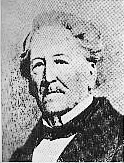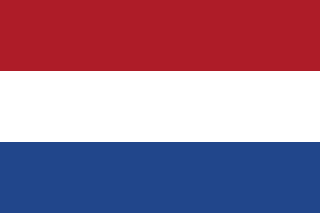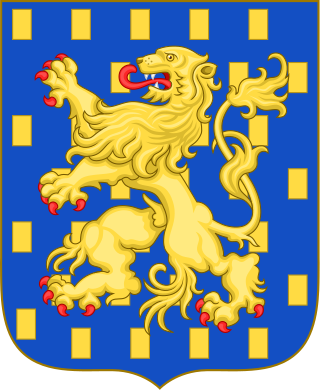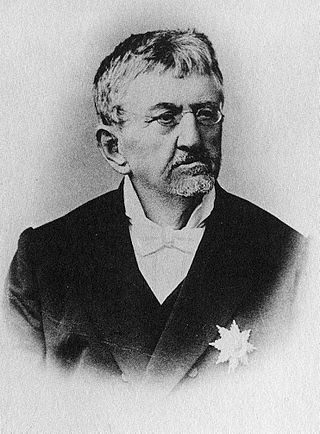
Orangism was a movement in the 19th century Grand Duchy of Luxembourg favouring the personal union of the Netherlands and Luxembourg under the House of Orange-Nassau.

Orangism was a movement in the 19th century Grand Duchy of Luxembourg favouring the personal union of the Netherlands and Luxembourg under the House of Orange-Nassau.
Made up of many notable figures, mainly nobles and Roman Catholic clergy, they were moderate liberals or conservative-liberals and slightly anti-clerical. At first they favoured maintaining the Grand Duchy's autonomous status and, especially during the Belgian Revolution, opposed it being merged into Belgium. In the end the western part of the Grand Duchy (the present province of Luxembourg) passed to Belgium, whilst the eastern part and the Orange grand duchy continued as an independent state.
In 1890 the heads of the House of Orange were grand dukes of Luxembourg, but on the death of king and grand duke William III in 1890 he was succeeded by his relation Adolphe as grand duke since Luxembourg's constitution did not allow a woman (Princess Wilhelmina) to hold the throne.
The movement's newsletter was the Journal de la Ville et du Pays Luxembourg. [1]
The movement was led by Gaspard-Théodore-Ignace de la Fontaine (1787–1871) and other notable members included:
|
|

The history of Luxembourg consists of the history of the country of Luxembourg and its geographical area.

The United Kingdom of the Netherlands is the unofficial name given to the Kingdom of the Netherlands as it existed between 1815 and 1830. The United Netherlands was created in the aftermath of the Napoleonic Wars through the fusion of territories that had belonged to the former Dutch Republic, Austrian Netherlands, and Prince-Bishopric of Liège in order to form a buffer state between the major European powers. The polity was a constitutional monarchy, ruled by William I of the House of Orange-Nassau.

A grand duchy is a country or territory whose official head of state or ruler is a monarch bearing the title of grand duke or grand duchess.
The grand ducal family of Luxembourg constitutes the House of Luxembourg-Nassau, headed by the sovereign grand duke, and in which the throne of the grand duchy is hereditary. It consists of heirs and descendants of the House of Nassau-Weilburg, whose sovereign territories passed cognatically from the House of Nassau to the House of Bourbon-Parma, itself a branch of the Spanish royal house which is agnatically a cadet branch of the House of Capet that originated in France, itself a derivative dynasty from the Robertians and the Karlings and the founding house of the Capetian dynasty.

The Grand Duke of Luxembourg is the head of state of Luxembourg. Luxembourg has been a grand duchy since 15 March 1815, when it was created from territory of the former Duchy of Luxembourg. It was in personal union with the United Kingdom of the Netherlands until 1890 under the House of Orange-Nassau. Luxembourg is the world's only sovereign Grand Duchy and since 1815, there have been nine monarchs, including the incumbent, Henri.

Adolphe was Grand Duke of Luxembourg from 23 November 1890 to his death on 17 November 1905. The first grand duke from the House of Nassau-Weilburg, he succeeded King William III of the Netherlands, ending the personal union between the Netherlands and Luxembourg. Adolphe was Duke of Nassau from 20 August 1839 to 20 September 1866, when the Duchy was annexed to the Kingdom of Prussia.

The Southern Netherlands, also called the Catholic Netherlands, were the parts of the Low Countries belonging to the Holy Roman Empire which were at first largely controlled by Habsburg Spain and later by the Austrian Habsburgs until occupied and annexed by Revolutionary France (1794–1815).

Marie-Adélaïde, was Grand Duchess of Luxembourg from 1912 until her abdication in 1919. She was the first Grand Duchess regnant of Luxembourg, its first female monarch since Duchess Maria Theresa and the first Luxembourgish monarch to be born within the territory since Count John the Blind (1296–1346).

The Order of the Oak Crown is an order of the Grand Duchy of Luxembourg.

The House of Nassau is a diversified aristocratic dynasty in Europe. It is named after the lordship associated with Nassau Castle, located in present-day Nassau, Rhineland-Palatinate, Germany. With the fall of the Hohenstaufen in the first half of the 13th century royal power within Franconia evaporated and the former stem duchy fragmented into separate independent states. Nassau emerged as one of those independent states as part of the Holy Roman Empire. The lords of Nassau were originally titled "Count of Nassau", subject only to the Emperor, and then elevated to the princely class as "Princely Counts". Early on they divided into two main branches: the elder (Walramian) branch, that gave rise to the German king Adolf, and the younger (Ottonian) branch, that gave rise to the Princes of Orange and the monarchs of the Netherlands.

The Duchy of Luxembourg was a state of the Holy Roman Empire, the ancestral homeland of the noble House of Luxembourg. The House of Luxembourg became one of the most important political forces in the 14th century, competing against the House of Habsburg for supremacy in Central Europe. They would be the heirs to the Přemyslid dynasty in the Kingdom of Bohemia, succeeding to the Kingdom of Hungary and contributing four Holy Roman Emperors until their own line of male heirs came to an end and the House of Habsburg received the territories that the two Houses had originally agreed upon in the Treaty of Brünn in 1364.

The Treaty of London, often called the Second Treaty of London after the 1839 Treaty, granted Luxembourg full independence and neutrality. It was signed on 11 May 1867 in the aftermath of the Austro-Prussian War and the Luxembourg Crisis. It had wide-reaching consequences for Luxembourg and for relations among Europe's great powers.

Lambert Joseph Emmanuel Servais was a Luxembourgish politician. He held numerous offices of national importance, foremost amongst which was in serving as the fifth prime minister of Luxembourg, for seven years, from 3 December 1867 until 26 December 1874.

The Order of the Gold Lion of the House of Nassau is a chivalric order shared by the two branches of the House of Nassau.
The Constituent Assembly of Luxembourg was a constituent assembly called in 1848 in Luxembourg to write and pass a new national constitution.
The military history of Luxembourg is central to the formation of Luxembourg as a nation from its formation around Luxembourg Castle in 963. A place of strategic military significance, Luxembourg had been fortified since the 10th century by over 50,000 m2 (538,195.52 sq ft) of walls and towers. Ruled by the House of Luxembourg in the early medieval period, Luxembourg was subsequently invaded by the Bourbons, Habsburgs, Hohenzollerns, and the French, among others.
The Assembly of Estates was the legislature of Luxembourg from 1841 to 1848, and again from 1856 to 1868.
The Revolution of 1848 in Luxembourg was part of the revolutionary wave which occurred across Europe in 1848. The Grand-Duchy of Luxembourg at that time was in personal union with the Kingdom of the Netherlands.

In the early 19th century, the Grand Duchy of Luxembourg was ruled in personal union by the King of the Netherlands, William I. The territory that is now Belgium was similarly part of the United Kingdom of the Netherlands. When the Belgian Revolution occurred in 1830, most of Luxembourg rallied to this Revolution, and accepted Belgian rule. The exception was the fortress and capital, Luxembourg City, which housed a Dutch-German garrison and remained loyal to William I. This led to a de facto separation of the country from 1830-1839, when most of it was loyal to and administered by Belgium, while one part retained allegiance to the Netherlands. The situation was resolved in 1839 when the international great powers and William I agreed that Luxembourg would remain in his possession, and lose its French-speaking parts to the new country of Belgium.